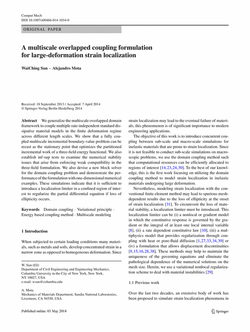 The paper, "A multiscale overlapped coupling formulation for large-deformation strain localization", written by WaiChing Sun and Alejandro Mota, has just published online by Computational Mechanics.
0 Comments
Concurrent and Hierarchical Multiscale Modeling of Shear bands in Fluid Infiltrating Solids
Steve WaiChing Sun, Assistant Professor, Columbia University [email protected] Monday, May 12, 11 am, 1047 Engineering Research Facility Abstract: Many man-made and natural geological processes may lead to the inceptions and propagations of narrow zones in which significant inelastic deformation concentrates. Examples include shear bands, compaction bands, fractures and joints. Due to the difference in spatial scales between the thickness of the localized zone and the rest of the deformable body, these localized diffusion-deformation processes can be approximated as a strong discontinuous displacement field across interfaces. Depending on how microstructural attributes (e.g. porosity, tortuosity and pore size distribution) evolve, these localized zones may become flow barriers or conduits. The objective of this study is to derive and implement multiscale models that capture the post-bifurcated localized responses of shear band formed in fluid infiltrating solids. Our continuum model features an equal-order mixed finite element that discretizes both the displacement, pore pressure and temperature. By introducing a projection-based stabilization technique, the model is capable of producing stable solution and a multi-physical variational localization element is used to admit displacement and pore pressure jumps. To enable concurrently coupling between micro- and macro-scale hydro-mechanical simulations, we extend the Arlequin formulation such that hydro-mechanical coupling effects can be captured in a concurrent multiscale framework. We recast the poromechanics problems as a saddle point that optimizes the constrained partitioned incremental work of a multi-field energy functional. By introducing appropriate Lagrange multiplier fields and compatibility energy functionals, we enforce the weak compatibility of the hydro-mechanical responses in the multiscale overlapped domain. Modified inf-sup tests are established to examine the numerical stability issues of the multiphysics Arlequin formulation.  Title: A DEM-LBM analysis on permeability evolutions during the formation of a dilatant shear band Author (Invited): Steve Sun, Columbia University Abstract:This talks presents a multi-scale lattice Boltzmann/finite element scheme that quantitatively links particulate mechanics to hydraulic properties of a grain assembly obtained from a simple shear discrete element simulation. A spatial homogenization is performed to recover the macroscopic stress from the micro-mechanical forces. The pore geometries of the shear band and host matrix are then quantitatively evaluated through morphology analysis and flow simulations. Hydraulic properties estimated from multiscale flow simulations are compared with those inferred from volume averaging and geometric averaging schemes. Results from the discrete element simulations imply that grain sliding and rotation occur predominately within the dilatant shear band. These granular motions lead to dilation of pore space inside the shear band and increases in local permeability. While considerable anisotropy in the contact fabric is observed within the shear band, anisotropy of the permeability is, at most, modest in the assemblies composed of spherical grains. |
Group NewsNews about Computational Poromechanics lab at Columbia University. Categories
All
Archives
July 2023
|

 RSS Feed
RSS Feed